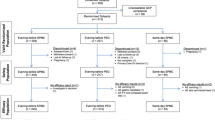Abstract
Background
Four liters or more of orally taken polyethylene glycol solution (PEG) has proved to be an effective large-bowel cleansing method prior to colonoscopy. The problem has been the large volume of fluid and its taste, which is unacceptable to some examinees. We aimed to investigate the effectiveness of 2 l PEG combined with senna compared with 4 l PEG for bowel preparation.
Methods
The design was a single-center, prospective, randomized, investigator-blinded study with parallel assignment, in the setting of the Endoscopy Unit of Umeå University Hospital. Outpatients (n = 490) scheduled for colonoscopy were enrolled. The standard-volume arm received 4 l PEG, and the low-volume arm received 36 mg senna glycosides in tablets and 2 l PEG. The cleansing result (primary endpoint) was assessed by the endoscopist using the Ottawa score. The patients rated the subjective grade of ease of taking the bowel preparation. Analysis was on an intention-to-treat basis.
Results
There were significantly more cases with poor or inadequate bowel cleansing after the low-volume alternative with senna and 2 l PEG (22/203) compared with after 4 l PEG (8/196, p = 0.027). The low-volume alternative was better tolerated by the examinees: 119/231 rated the treatment as easy to take compared with 88/238 in the 4 l PEG arm (p = 0.001).
Conclusions
4 l PEG treatment is better than 36 mg senna and 2 l PEG as routine colonic cleansing before colonoscopy because of fewer failures.


Similar content being viewed by others
References
Bowles CJ, Leicester R, Romaya C, Swarbrick E, Williams CB, Epstein O (2004) A prospective study of colonoscopy practice in the UK today: are we adequately prepared for national colorectal cancer screening tomorrow? Gut 53:277–283
DiPalma JA, Brady CE III, Stewart DL, Karlin DA, McKinney MK, Clement DJ, Coleman TW, Pierson WP (1984) Comparison of colon cleansing methods in preparation for colonoscopy. Gastroenterology 86:856–860
Beloosesky Y, Grinblat J, Weiss A, Grosman B, Gafter U, Chagnac A (2003) Electrolyte disorders following oral sodium phosphate administration for bowel cleansing in elderly patients. Arch Intern Med 163:803–808
Mishra R, Kaufman D, Mattern J III, Dutta SK (2005) Severe hyperphosphatemia and hypocalcemia caused by bowel preparation for colonoscopy using oral sodium phosphate in end-stage renal disease. Endoscopy 37:1259–1260
Markowitz GS, Nasr SH, Klein P, Anderson H, Stack JI, Alterman L, Price B, Radhakrishnan J, D’Agati VD (2004) Renal failure due to acute nephrocalcinosis following oral sodium phosphate bowel cleansing. Hum Pathol 35:675–684
Hookey LC, Depew WT, Vanner SJ (2006) Combined low volume polyethylene glycol solution plus stimulant laxatives versus standard volume polyethylene glycol solution: a prospective, randomized study of colon cleansing before colonoscopy. Can J Gastroenterol 20:101–105
Rostom A, Jolicoeur E (2004) Validation of a new scale for the assessment of bowel preparation quality. Gastrointest Endosc 59:482–486
Iida Y, Miura S, Asada Y, Fukuoka K, Toya D, Tanaka N, Fujisawa M (1992) Bowel preparation for the total colonoscopy by 2,000 ml of balanced lavage solution (Golytely) and sennoside. Gastroenterology Jpn 27:728–733
Tooson JD, Gates LK Jr (1996) Bowel preparation before colonoscopy. Choosing the best lavage regimen. Postgrad Med 100:203–204, 207–212, 214
Church JM (1998) Effectiveness of polyethylene glycol antegrade gut lavage bowel preparation for colonoscopy—timing is the key!. Dis Colon Rectum 41:1223–1225
Parra-Blanco A, Nicolas-Perez D, Gimeno-Garcia A, Grosso B, Jimenez A, Ortega J, Quintero E (2006) The timing of bowel preparation before colonoscopy determines the quality of cleansing, and is a significant factor contributing to the detection of flat lesions: a randomized study. World J Gastroenterol 12:6161–6166
Acknowledgments
The authors thank the staff at the Endoscopy Unit of Umeå University Hospital and Assistant Professor Ingeborg Waernbaum at the Department of Statistics, Umeå University. Professors P. Naredi and E. Nilsson are acknowledged for comments improving the manuscript. Ali Janbaz, MD has been of great help with quality assessment of the study database. Grant support from the Fund of Gastroenterological Research at the Department of Medicine, Umeå University Hospital and the County Council of Västerbotten is acknowledged.
Disclosures
Authors M.M. Haapamaki, B. Sandzén B, and M. Lindstrom have no conflicts of interest or financial ties to disclose.
Author information
Authors and Affiliations
Corresponding author
Additional information
This report refers to registered study NCT00390598 (ClinicalTrials.gov identifier).
Rights and permissions
About this article
Cite this article
Haapamäki, M.M., Lindström, M. & Sandzén, B. Low-volume bowel preparation is inferior to standard 4 l polyethylene glycol. Surg Endosc 25, 897–901 (2011). https://doi.org/10.1007/s00464-010-1293-6
Received:
Accepted:
Published:
Issue Date:
DOI: https://doi.org/10.1007/s00464-010-1293-6




